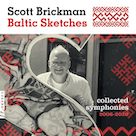

Scott Brickman: Baltic Sketches: Collected Symphonies 2006-2020
Navona Records
Even though its focus is squarely on symphonies created during a fifteen-year period, Baltic Sketches nevertheless provides a splendid gateway into composer Scott Brickman's world. It does so even more when each of the four symphonies is pocket-sized—no monumental Mahler-length adagios here—and rich in melodic content. Also helping to distinguish the four is the fact that the material draws for inspiration from Brickman's Baltic and Slavic ancestry; whereas the fifth symphony, for example, includes elements of Latvian folk music, from dances and songs to Lutheran liturgical music, the sixth, scored for wind ensemble alludes to the Lutheran chorale, “In Dulci Jubilo.” At the same time, Brickman, born in Oak Park, Illinois in 1963, isn't unaware of socio-political events of current global import, as shown by the impact of the Middle East and climate crises on the writing of the first symphony. Such details add to the arresting qualities each of the works possesses.
His engagement with Latvian culture hasn't developed from afar either. Beginning in 2018, he's studied during the summer months at the University of Latvia (currently Professor of Music and Education at the University of Maine at Fort Kent, Brickman received his doctorate at Brandeis University in 1996) and developed the fifth symphony during 2019 while in the Czech Republic and Latvia. A Latvian folk character is clearly audible in its spirited opening movement, not only in the syncopated dance rhythms but in the enigmatic allusiveness of the chromatic melodic material. The spidery crawl of a mallet instrument also lends the movement, loosely adhering to sonata form, a macabre quality reminiscent of a devilish Shostakovich scherzo. Performed with gusto by the Zagreb Philharmonic Orchestra and conductor Ivan Josip Skender, the symphony pivots to gentler territory for the second part, its “Cantabile (Valse Melancholique)” marking referencing its generally singing, romantic tone and the movement's inspiration, Emil Darzin's Valse Melancolique. The aptly titled “Energico” movement closes the symphony's circle with shifting metres and dance gestures similar to those animating the first movement.
Even more compact than the fifth, the first symphony, in four parts with the third and fourth appearing without pause, weighs in at a svelte twelve minutes. Delivered this time by the Kiev Philharmonic under Robert Ian Winstin's direction, the work exudes a quasi-neoclassical character despite the fact that it's based on twelve-tone rows. Eschewing descriptive markings, the movements advance from “I” though “IV,” the sonata-styled first a dramatic, almost angst-ridden expression and the contrasting second a ponderous study in solemnity and introspection. While the orchestra's other sections are engaged, its string players are emphasized in the work's opening movements. The conjoined third and fourth parts advance from a boisterous scherzo to an aggressive finale powered by insistent strings and horns.
Unlike the multi-part design of the others, Brickman's fourth symphony, “Restoration” (2018), doesn't quote folk songs directly but was inspired nonetheless by music from Latvia, Lithuania, Poland, and Ukraine. With Jirí Petrdlík conducting the Janácek Philharmonic Ostrava, the eleven-minute, action-packed work ranges widely, venturing as it does into portentous, military-styled zones and into others less war-torn but still blustery—don't be surprised if Shostakovich's seventh symphony (aka Leningrad Symphony) comes to mind as Brickman's plays out. A slight shift in presentation occurs with the advent of the sixth symphony when the “sinfonia” is scored for wind ensemble. With Petrdlík helming the Filharmonie Brno, the three-part work draws once again from Latvian culture, in its opening “Maestoso” movement, for instance, the Lithuanian singing tradition known as “Sutartine.” The ponderous central movement, “Cantabile: Risoluto,” broods soberly as its percussion-accented parts create a sense of anticipation and even foreboding. Brighter in mood is the album-closing “Grandioso,” in which side-long references to “In Dulci Jubilo” can be glimpsed.
As the release concludes, the impression forms that Brickman has much in common with twentieth-century composers such as Prokofiev, Bartok, and, of course, Shostakovich. That puts him in extremely good company, of course, and it's surely no coincidence that he, like them, has drawn directly from Eastern European folk traditions and allowed that material to colour his own artistic creations.April 2025